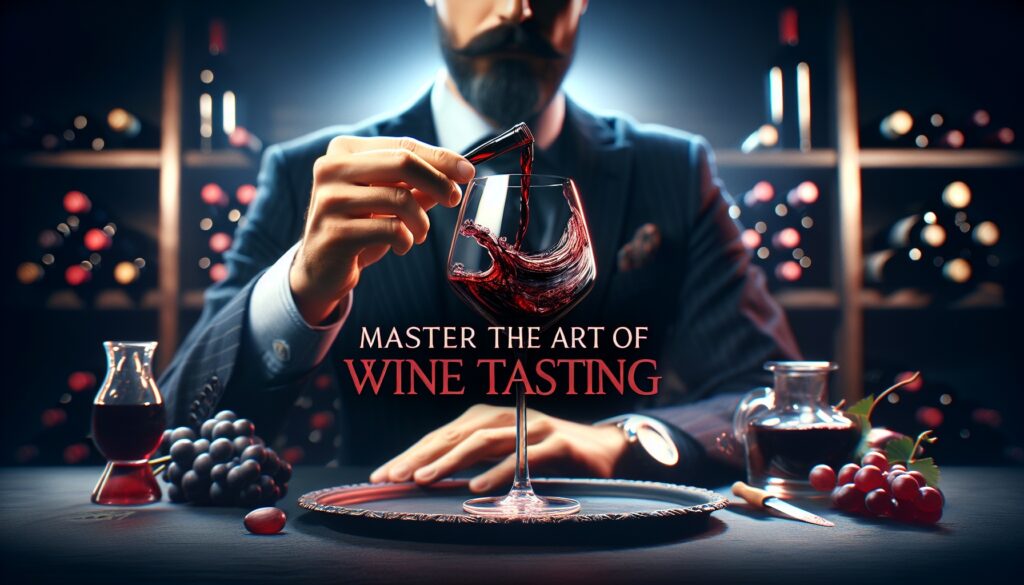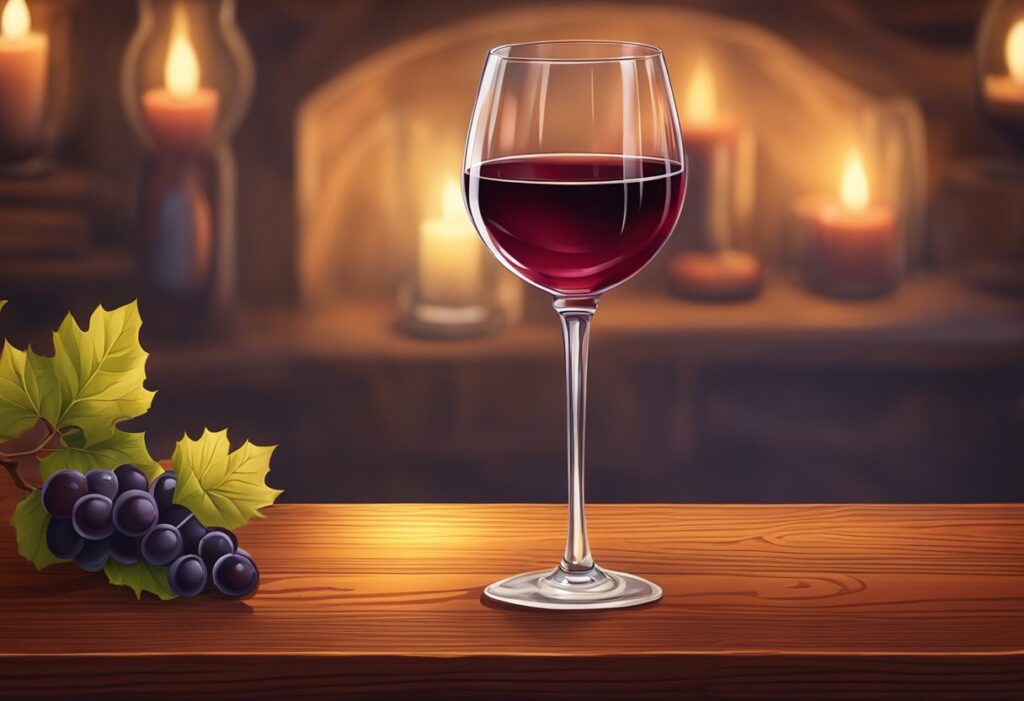Embarking on a wine tasting journey offers both a delightful experience and a means to expand your understanding of wine. To fully appreciate the event, it’s important to approach it with a bit of planning and research.
Familiarizing yourself with the types of wines offered at the winery you plan to visit can enhance your appreciation and enable you to ask more informed questions. Remember, each vineyard has its characteristics and specialties; knowing these can make your visit more enjoyable.

Before you set foot in a winery, it’s wise to consider the conditions that could influence your tasting experience. Ensuring you’re not wearing strong fragrances is one such consideration, as they can interfere with your ability to smell and thus taste the wine.
Dressing comfortably can also affect your experience, allowing you to focus entirely on the wine rather than being distracted by discomfort. Keep in mind that wine tasting isn’t just about the taste—it’s a multi-sensory experience that involves sight, smell, and of course, taste.
Key Takeaways
- Preparing with basic knowledge about the winery and wine varieties enhances the tasting experience.
- Dressing comfortably and avoiding strong fragrances helps maintain focus on the wine’s flavors.
- Wine tasting is a multi-sensory activity that engages sight and smell in addition to taste.
Understanding Wine Tasting
Embarking on a wine tasting journey equips you with the ability to discern the nuances of different wines. Recognize how swirling enhances a wine’s aroma, and learn how various tasting formats can influence your experience.
The Basics of Wine Tasting
Your adventure in wine tasting begins with mastering the proper techniques which are crucial to appreciating the complexities of wine. A quintessential wine glass, an essential tool, should have a stem to prevent heat from your hand warming the wine. Start by examining the color and clarity.
Then, swirl the wine gently to oxygenate it, which intensifies the aromas. A deep sniff follows, letting you detect layered flavors and notes. When you take a sip, let the wine cover your palate, noting traits like sweetness, acidity, body, and tannins. A palate cleanser between wines ensures each tasting is experienced on a fresh note.
- Color: Look at the depth and intensity.
- Swirl: Integrate air to release the full spectrum of smells.
- Aroma: Identify common scents like fruits, flowers, or herbs.
- Palate: Assess the wine’s structure on your tongue.
Different Wine Tasting Formats
Wine tasting can be an intimate casual experience or a structured exploration. At a tasting room in a winery, you’ll typically try a selection curated by the winemaker representing the wine regions‘ terroir. Here, your tasting skills will be honed as you compare wines side by side.
Alternatively, structured tastings might involve guided sessions with a sommelier, introducing themes such as vertical tastings—sampling the same wine across different years—or comparisons across different regions or winemakers.
- Casual Tasting: Relaxed and sociable, often self-led.
- Guided Tasting: Educational with a focus on wine knowledge.
Remember, every sip offers a story from the grape to the glass, mirroring the artistry of winemaking and the richness of the vineyards where it all began.
Before You Go
Embarking on a wine tasting journey requires a bit of forethought to maximize your experience. From selecting the right attire to mapping out your day, these steps ensure your visit is both enjoyable and seamless.
Planning Your Visit
Choose Your Wine Region Wisely: Popular regions like Napa Valley, Santa Barbara, or Willamette Valley offer a plethora of wineries. Conduct a Google search to find one that aligns with your taste preferences and budget.
Make Reservations: Especially for well-known wineries, booking in advance is crucial. This not only secures your spot but also allows the winery to prepare for your arrival, providing a tailored experience.
Set Your Pace: Decide in advance how many wineries you wish to visit to comfortably pace yourself. Enjoying wine is not a race, and you’ll want to remember the wines you taste.
Arrange Transportation: Safety first — if you plan to visit multiple spots, consider hiring a driver or using a service that specializes in winery tours.
What to Wear
Dress for Comfort and Etiquette: Winery visits often involve walking through vineyards and cellars where terrain can be uneven. Opt for flats or comfortable shoes. Check if there’s a dress code; however, most wineries suggest casual attire.
- Upper wear: Choose breathable, light fabrics, and avoid white or light colors to hide any potential stains.
- Bottom wear: Go for relaxed fit trousers or a skirt that allows you to move freely.
- Accessories: A hat and sunglasses are your best friends for outdoor tastings, and they add a stylish touch.
Remember, wine tasting is an occasion where your senses should be at the forefront. Avoid heavily scented perfumes or lotions that could interfere with the aroma of the wines.
During the Wine Tasting
When you embark on a wine tasting journey, it’s not just the flavors that matter; it’s also about embracing proper tasting room etiquette, interacting thoughtfully with winery staff, and applying the right wine tasting techniques.
Tasting Room Etiquette
Upon entering the tasting room, you must remember your presence affects those around you. Avoid wearing perfume or heavily scented lotions, as these can interfere with the wine’s natural aromas. It’s also considered good form to pace yourself, not just to fully appreciate each wine’s complexity, but to maintain a sense of decorum. To manage the alcohol content intake, make use of spittoons.
- Pacing: Alternate each taste with water, and consider spitting the wine.
- Etiquette: Dress appropriately, and refrain from overpowering fragrances.
Engaging with the Winery Staff
The people pouring your wine often possess a deep passion and knowledge about their craft. A sommelier or winemaker in attendance is invaluable for your understanding of wine. Ask specific questions about the tannins, acidity, or malolactic fermentation processes. This not only enriches your experience but also serves as a sign of respect for their work. Be sure to take notes of their insights; it will enhance your ability to recall the wines later.
- Interaction: Address staff with interest and respect; they’re your guides.
- Learning: Inquire about fruit and secondary aromas, winemaking techniques, and varietal-specific characteristics.
Wine Tasting Techniques
Taste wine like a pro by focusing on the concentration and complexity of flavors. Begin with lighter wines like Chardonnay or Riesling, and move towards bolder varieties like Cabernet Sauvignon or Zinfandel. Swirl the glass to observe the wine’s “legs” or viscosity, which can hint at alcohol content.
Then, sniff to discern fruit aromas before you taste. On your palate, identify the balance between tannins, acidity, and alcohol content. If available, use a tasting sheet to note your impressions of each sample.
- Order: Start with light wines and proceed to fuller-bodied ones.
- Technique: Swirl, sniff, sip, and savor each wine to assess its profile.
After Your Tasting
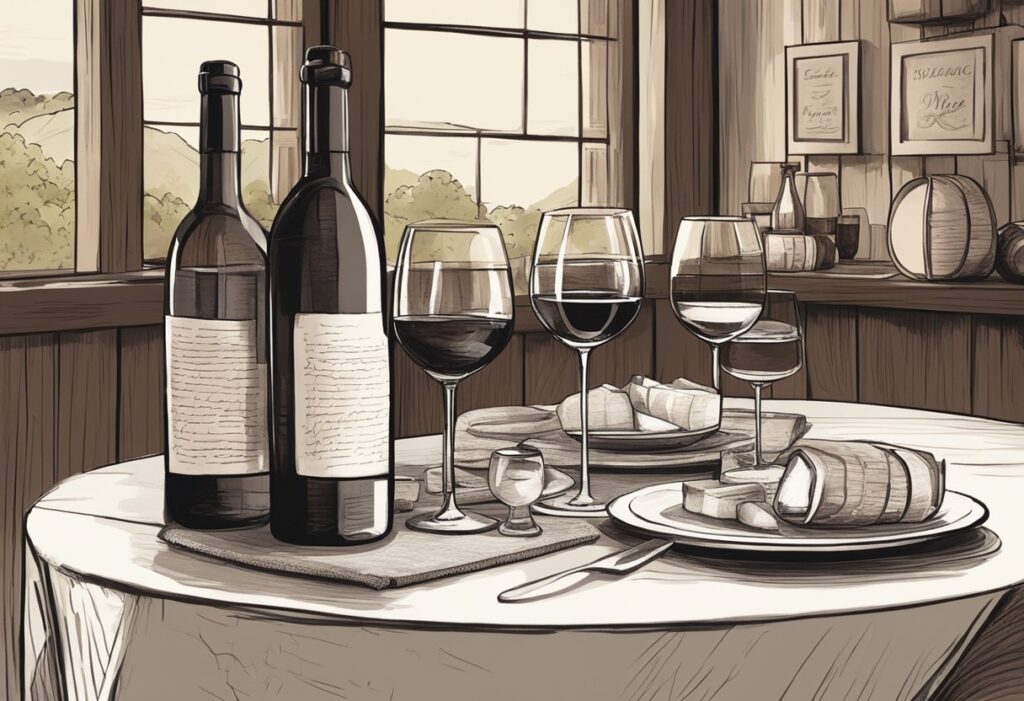
Once your wine tasting has concluded, the true enrichment of the experience begins with reflection on the wines you sampled and considering how they might pair with food.
Reflecting on the Experience
Take a few minutes to review your tasting notes and consider your initial reactions to each wine. This is the time to remember the winemaking techniques shared by the winery and the passion that goes into each bottle. What aromas and flavors stood out to you? Did the red wines offer a different experience than the white wines? Jot down any final thoughts or feedback you may have for the winery, as this can be beneficial for both you and the winemaker.
Wine and Food Pairing
Armed with your tasting notes, you’re now ready to explore wine and food pairing. This is where you can get creative, pairing different wines with menu items should you decide to have lunch at the winery’s picnic areas, or later at home. For example, a crisp white wine may complement a light seafood dish, while a bold red pairs delightfully with a juicy steak. Here’s a quick guideline to help:
- White Wines: Ideal with chicken, fish, and lightly flavored foods.
- Red Wines: Best matched with red meat, game, and heavier dishes.
Remember, these pairings are suggestions—trust your palate and preferences for the most enjoyable experience.
Additional Tips
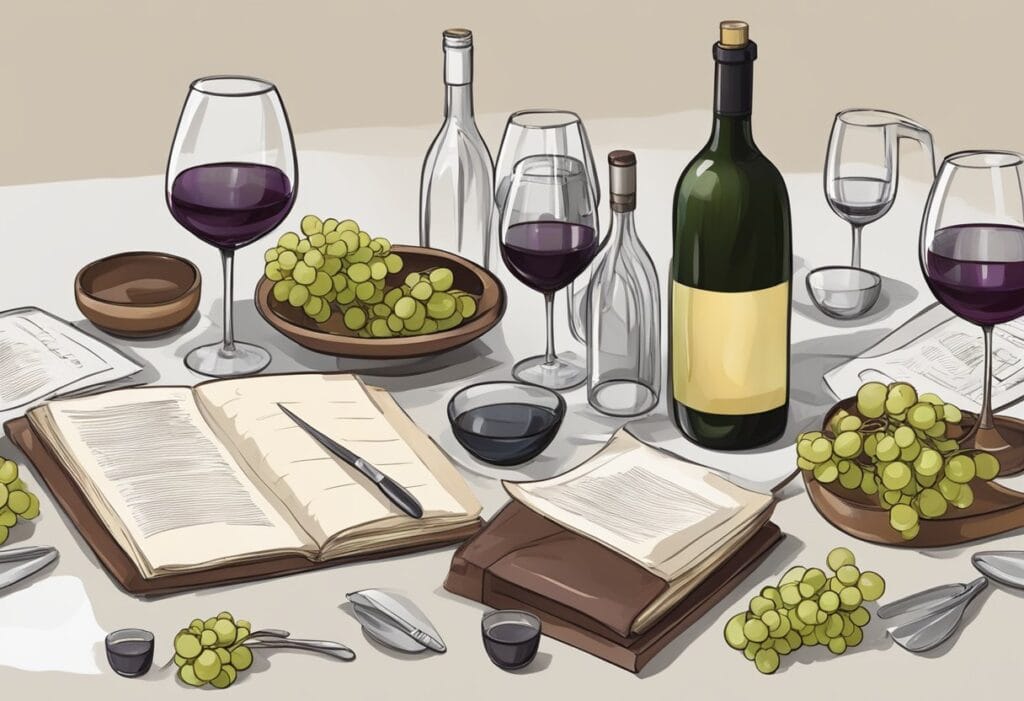
Before embarking on your wine tasting journey, consider the financial aspects and how you can foster relationships during your winery visit. These tips ensure you get the most out of your experience both economically and socially.
Financial Aspects
Budgeting is crucial when planning a wine tasting. Be aware that tasting fees can vary widely from one winery to another. To make the most of your budget, research the cost of tastings beforehand and set aside a reasonable amount for this expense.
- Tip: Some wineries offer to waive the fee if you purchase a bottle of wine. This can be a smart way to enjoy the tasting and take home a souvenir.
- Suggestion: Always ask if there’s a discount for large groups or if there are any ongoing promotions.
Building Relationships
Interacting with the winemakers and staff can greatly enhance your wine tasting experience. Take the opportunity to ask questions and learn from their expertise.
- Engagement: Show genuine interest in the production process; your engagement could lead to a more in-depth experience.
- Connections: If you enjoy the wine, consider joining the winery’s partner programs or clubs to get exclusive offers and invitations to private events.
Etiquette Tip: Always call ahead to inquire whether you need to make reservations. This not only ensures your spot but also shows respect for the winery’s scheduling.
Remember to dress appropriately; select clothing that’s comfortable for walking and suitable for the weather. Avoid wearing sandals if you’re going to walk in the vineyards, and bring sunglasses for outdoor tastings. Following proper wine tasting etiquette will make your experience more enjoyable and help you build lasting connections with the winemakers and fellow wine enthusiasts.
Considerations for Special Groups
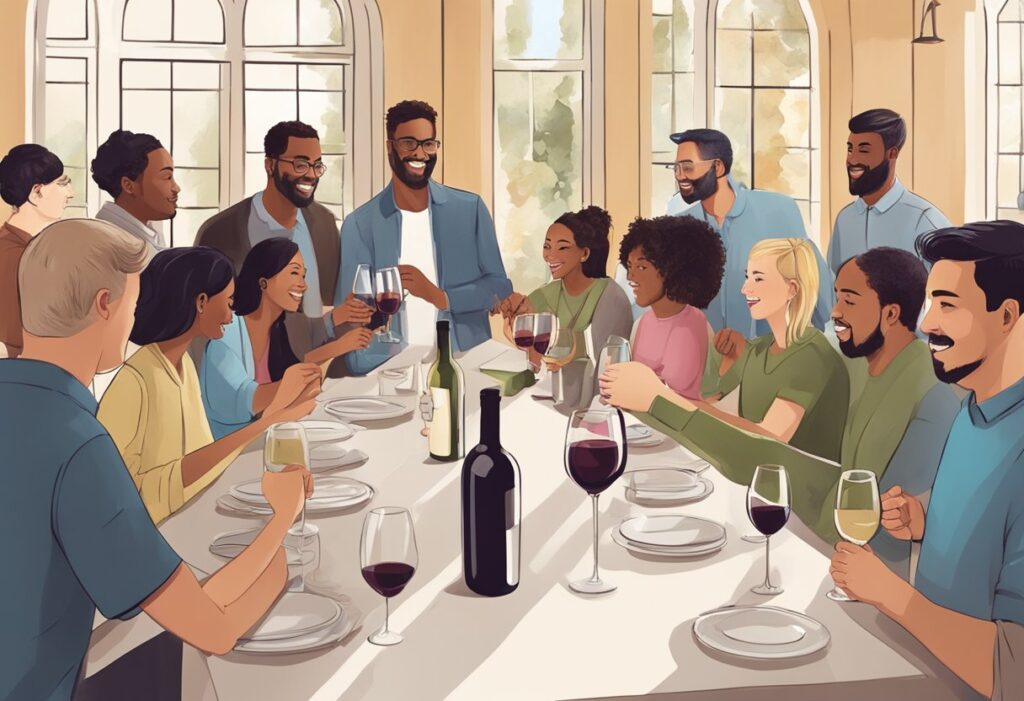
When planning a wine tasting, it’s vital to consider the specific needs of any special groups within your party to ensure a comfortable and inclusive experience.
Family-Friendly Wineries
You might be wondering whether a wine tasting can accommodate family outings. Family-friendly wineries often have designated areas for kids, allowing them to play safely while adults enjoy the tasting. Look for wineries that offer non-alcoholic drinks and activities for younger family members. Reservations are particularly important for family groups to secure spots that can cater to children’s needs, making your visit more relaxed.
- Activities for kids: Ensure the winery offers age-appropriate entertainment.
- Seating: Verify there’s ample and comfortable seating for your whole family.
Accessibility Options
It’s essential that everyone in your party can enjoy the wine tasting experience without discomfort or barriers. Wineries with accessibility options provide ease of movement for anyone requiring additional support, such as wheelchair users. When booking, confirm the facility’s accessibility features like ramps or special restrooms. Comfortable footwear is advised, notably flats or sandals, to navigate the venue easily.
- Pace yourself: Evaluate the day’s schedule to accommodate everyone’s physical needs.
- Driver: Plan ahead and designate a driver or arrange transportation to ensure a stress-free outing for group members with mobility issues.
Frequently Asked Questions
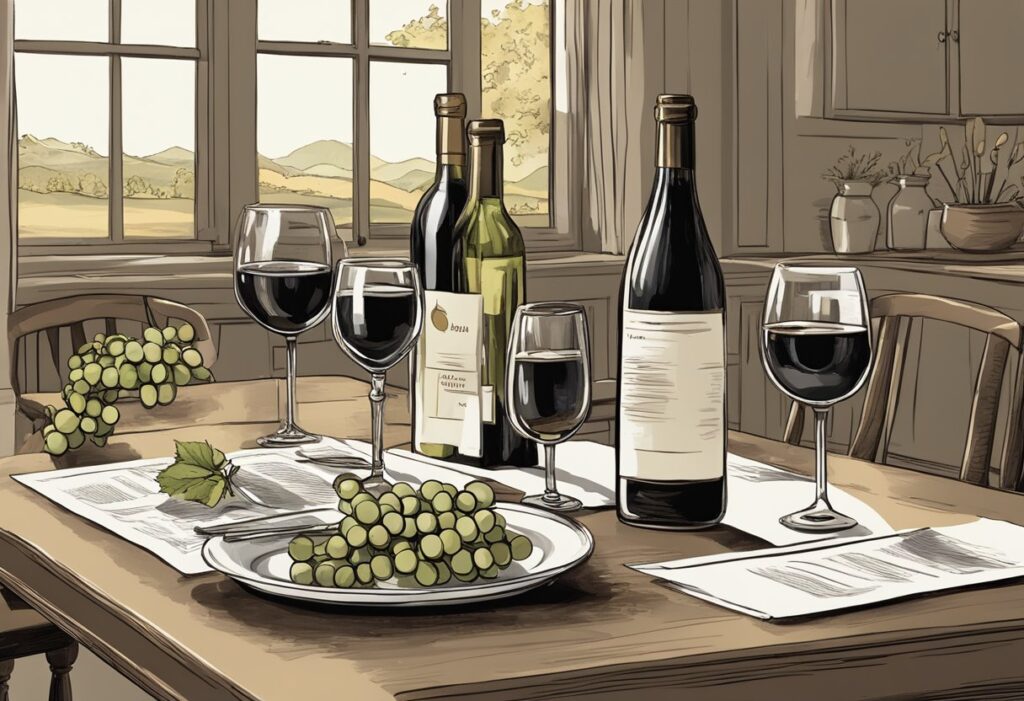
Before attending a wine tasting, certain preparation and etiquette can significantly enhance your experience. Understanding what to expect and how to engage with the wine will help you appreciate the full spectrum of flavors and aromas.
What are the essential etiquette tips for attending a wine tasting?
At a wine tasting, it’s important to mind your manners. Dress appropriately, often business casual, and avoid wearing strong fragrances that could interfere with the aroma of the wines. It’s polite to spit the wine into spittoons after tasting, which allows for experiencing multiple wines without overconsumption.
How should one prepare for a wine tasting to enhance the experience?
To prepare, hydrate and eat a light meal beforehand to balance the effects of alcohol. Cleanse your palate with water or neutral foods like crackers between tastings. Familiarizing yourself with common wine terms can also enrich your tasting experience.
What can you typically expect in terms of wine servings at a tasting session?
Wine servings at a tasting are typically small pours, about 1 to 2 ounces. These sample sizes allow you to taste a variety without becoming inebriated. It’s normal to not finish every glass; you can pour out what you don’t wish to drink.
Are there any costs associated with wine tasting, and what factors influence them?
Wine tastings can vary in cost, influenced by the winery’s prestige, number of wines offered, and any additional amenities provided. Some may offer complimentary tastings, while others charge a fee, which is sometimes waived with a wine purchase.
What are the key observations and techniques to employ during wine tasting?
Focus on sight, smell, and taste. Observe the wine’s color and clarity, sniff for aroma complexity, and assess the flavors and structure as you taste. Swirling the wine in your glass can help open up its scent profile.
What should one consider bringing along when going to a wine tasting event?
Bring along a notepad and camera. A notepad allows you to jot down your impressions of the wines, and a camera lets you record labels of favorites. It’s also wise to have a designated driver or use a ride service if you plan to consume alcohol.
